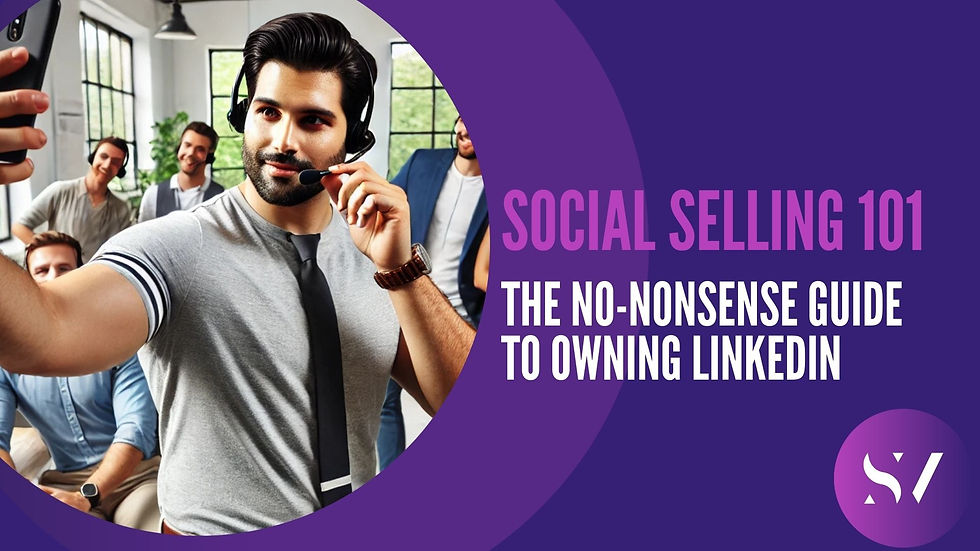Sales 101: A Guide to Meaningful Engagement
- Sara Osterholzer
- Apr 14, 2024
- 4 min read
Updated: Nov 8, 2024
Sales success isn’t about hard-sell tactics or memorising scripts. It’s about knowing when to listen, what to ask, and how to guide. This guide distils the essentials of consultative selling - helping SDRs and AEs engage in a way that’s effective, human, and built on genuine connection.

The Evolution of Sales: From Pushy to Consultative
Long gone are the days when sales was all about talking louder and faster. Today’s sales environment is about connection, insight, and authenticity. At Second Voice, we believe consultative selling is the key to standing out in a crowded digital landscape. Think of yourself as a helpful guide rather than a persistent persuader. Instead of trying to win them over immediately, you’re here to partner with clients and help them find the best solution.
Consultative selling revolves around understanding. First, you get a sense of their world - where they’re coming from, what they’re facing. Then, you thoughtfully share insights that help them see the value of your solution in their unique context. And to do that, we need to understand how buyers make decisions.
Understanding the Buyer’s Mindset: System 1 and System 2 Thinking
Every buyer comes to the conversation with their own mindset. Most start out in System 1 mode - let’s call it the autopilot. They’re guarded, busy, maybe a tad sceptical, and generally looking for an easy way to dismiss the call. Then there’s System 2 mode - analytical, deliberate, and open to considering solutions. Our job as consultative sellers is to guide buyers from that initial “not interested” mindset of System 1 into the thoughtful space of System 2, where they’re open to exploring options and seeing the value in our solutions.
But how do we encourage that shift? It’s a skill that takes time, patience, and the right tools. And this is where the consultative strategies and frameworks come into play.

Moving Towards Connection: Shifting Mindsets with the AUDIO Framework
Enter the AUDIO framework. Think of AUDIO as a map guiding us through the sales conversation, helping us move buyers from autopilot reactions to genuinely considering the benefits of what we offer. Each step - Attention, Understanding, Difficulty, Interest, and Options - is designed to create a seamless journey from the first point of contact to a place where the buyer is ready to act.
A - Attention
First impressions count. Right from the get-go, your focus is on grabbing their attention - not with a sales pitch, but with something relevant to their world. Acknowledge their challenges and show empathy. Remember, this isn’t about rattling off product features; it’s about resonating with their reality.
Example: “Hi [name], I know this is unexpected, but I’ve been working with others in [industry] facing challenges with [problem]. I thought you might relate.”
U - Understanding
Now that you’ve piqued their interest, it’s time to dive deeper. This stage is all about active listening. Use open-ended questions to draw out details about their goals, challenges, and day-to-day realities. Start with broad industry questions and then home in on specifics. You’re not just collecting facts; you’re building rapport and showing genuine interest.
Example: “What industry trends have impacted your goals this year?” followed by “How has your team adapted to these challenges?”
D - Difficulty
Here, you help them explore the potential obstacles they face if they don’t address their challenges. Encourage them to think through the cost of inaction by asking “what if” questions. This is where you help them feel the weight of their pain points and the value of finding a solution.
Example: “What impact does [unaddressed challenge] have on your team’s productivity?”
I - Interest
You’ve identified the challenges, and now it’s time to make the connection between their needs and your solution. This is where consultative selling shines. You’re not just selling a product - you’re presenting a genuine solution that fits their unique situation. Focus on value, benefits, and the positive change your solution brings.
Example: “You mentioned your struggle with [challenge]. Our solution directly addresses that by [specific benefit]. Does that sound like it could help?”
O - Options
And finally, present choices that fit their needs and budget. Buyers appreciate options, and this step empowers them to take ownership of the decision. With thoughtful guidance, you’re not pushing them towards a purchase; you’re helping them find a way forward that makes sense.
Example: “We offer [option 1] for comprehensive support, and [option 2] for a more focused approach. Which one feels like it might be a better fit?”
Bringing It All Together: Core Principles for Consultative Selling
AUDIO and the sales funnel give us structure, but the real magic comes from how we put these elements into practice. Here’s what to keep in mind as you go through each conversation:
Stay curious—authentic curiosity is at the heart of consultative selling.
Lead with value—always bring it back to how your solution helps them.
Handle objections with grace—questions and concerns aren’t obstacles; they’re openings.
Listen actively—summarise, clarify, and show you’re engaged.
Embrace a ‘no’ as a learning moment—sometimes “no” just means they need more information or reassurance.
At the end of the day, consultative selling isn’t about memorising scripts or closing every deal on the spot. It’s about shifting your perspective to see sales as a meaningful dialogue, an opportunity to listen, learn, and lead clients towards genuine solutions. With this approach, SDRs and AEs can build the kind of trust that goes beyond a single transaction and paves the way for long-term relationships that benefit everyone involved.



